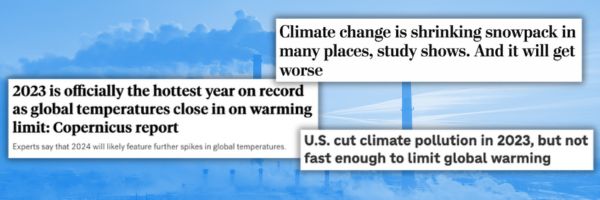 By Rep. Jamie Long
By Rep. Jamie LongDFL-Minneapolis
Climate change is transforming Minnesota in ways we’re only beginning to understand, but we know it’s an immediate threat to our state. As one of the fastest warming states in the country, Minnesota is already starting to feel the impacts of climate change. If we don’t address it and soon, Minnesota’s seasons, weather, and natural landscape will look very different by the time today’s children reach adulthood. Climate change is a global crisis, but the U.S. is the only country in the world that refused to join the landmark Paris Climate Agreement (it used to be us and Syria, but even Syria is now on board). This makes action at the state and local levels that much more critical.
Minnesotans are demanding that we do more to combat climate change. They’re telling us that we have a once-in-a-generation opportunity. We can build a thriving clean energy economy that would create thousands of good homegrown jobs, preserve our state’s natural beauty and resources, and protect the health of our communities. By transitioning to clean energy, we can once again lead the nation and be a part of finding the solutions to climate change. I believe in our ability as Minnesotans to come together and get things done!

We’ve been a national leader in this area before. In 2007, a bipartisan group of legislators, including Republican Governor Tim Pawlenty, passed the Next Generation Energy Act. This legislation enacted a bold vision for our state by implementing the first greenhouse gas reduction goals and a target of 25 percent renewable energy by 2025. It sounded ambitious at the time, and it was. But last year, thanks to advances in clean energy technology, Minnesota reached that 25 percent renewable energy goal nearly eight years ahead of schedule!
That’s a remarkable accomplishment. But we’re not on track to meet the targets for greenhouse gas reduction. Between 2005 and 2015, Minnesota reduced greenhouse gas emissions by 12 percent, not the 15 percent that we’d aimed for. And we’re not on track to meet our future goals either.
Minnesota has lost its role as a national leader. Other states have set more ambitious benchmarks that reflect the reality of our changing energy market and the scale of action the climate crisis requires. Three states – California, Hawaii, and New Mexico – have already committed to 100 percent clean energy. Others are right on their heels, including some of our neighbors. Governor Tony Evers has called for achieving this in Wisconsin by 2050, and Colorado Governor Jared Polis campaigned on completing the transition by 2040. If Minnesota doesn’t keep up, we’ll be left behind.
If Minnesota fails to act now and lead the transition to clean energy, we’re sacrificing more than our state pride. We’re leaving major job-creating opportunities on the table. Last year, for example, Minnesota didn’t even make the top 20 states for solar jobs, despite being home to the number one solar construction company in the country. Since we don’t have fossil fuels, we’re currently sending $13 billion out of state to buy energy each year. If we reduce our state’s dependence on fossil fuels, we could keep that money here in our communities. A groundbreaking study from the McKnight Foundation found that Minnesota could create up to 50,000 clean energy jobs and obtain 91 percent of our electricity from renewable sources in a cost effective way. That’s using current technology! Clean energy jobs are already growing twice as fast as Minnesota’s economy as a whole. It’s time that we build on that success.
The next generation of Minnesotans will face the consequences of our failure if we don’t act soon. Farmers will bear the immediate brunt of climate change. Rising temperatures and precipitation levels threaten to reduce our agricultural productivity. Scientists from the University of Minnesota have said that our environment and climate will resemble Kansas’s in just a few decades. If we don’t cut carbon pollution, we’re on track to lose boreal forest by 2070. By the time that my 8-month-old daughter is 50, the Boundary Waters would have no more boreal forest. Business as usual isn’t going to get the job done in time.
Doctors and nurses across our state are raising alarms about the health impacts of climate change. They’re seeing problems with asthma and allergies that they expect to intensify and higher rates of heat-related and tick-borne illnesses. In the Twin Cities, air pollution causes up to 2,000 early deaths annually. These health threats disproportionately impact low-income people and communities of color. Health issues will only get worse, and disparities would widen.
While the challenge before us may seem enormous, we’re now closer to 100 percent clean energy than ever before. Thanks to the hard work of many advocates and organizers, the calculus of what’s possible has changed.
The Minnesota House of Representatives has passed a historic energy budget. It would set Minnesota on a path towards achieving 100 percent clean energy by 2050. It includes support for community solar gardens, cleaner cars and buses, and more efficient buildings. This legislation sets us on a path towards a thriving clean energy future for Minnesota and a secure future for generations to come.
I’m proud of our energy budget, but this historic progress is credit to the amazing community leaders who have fought so hard for this moment! Hundreds of Minnesotans have come to the Capitol for public hearings, rallies, and meetings with legislators. Even more have knocked on doors, made phone calls, and told their stories across the entire state. This grassroots movement has brought together people from many backgrounds. Students, parents and grandparents, faith communities, farmers, medical professionals, scientists, and more are united by their belief in a clean energy future for Minnesota. If people like you continue to tell your unique stories and stand for what you believe in, there’s no limit to what we can accomplish together.

